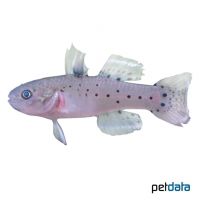Knight Goby (Stigmatogobius sadanundio)
| Knight Goby Stigmatogobius sadanundio | |
|---|---|
| Name | Knight Goby |
| Name Lat. | Stigmatogobius sadanundio |
| Synonym | Gobius sadanundio |
| Family | Gobies |
| Family lat. | Gobiidae |
| Order | Gobies |
| Order lat. | Gobiiformes |
| Origin | Southeast Asia, Oceania |
| Habitat | Estuaries |
| Diet | Omnivore |
| pH | 7.0-8.5 |
| Behavior | Semi-aggressive |
| Keeping | Pair, harem |
| Care Level | Moderate |
| Reproduction | Cave spawner |
| Breeding | Difficult |
| Life Span | 5-7 years |
| Protection | No |
| Metric Units | |
| Size | 8-9 cm |
| Temperature | 20-26 °C |
| Hardness | 10-20 °dH |
| Aquarium | ~ 150 l |
| US Units | |
| Size | 3"-3.5" |
| Temperature | 68-79 °F |
| Hardness | 178-356 ppm |
| Aquarium | ~ 40 gal |
Distribution and habitat
Knight gobies are widespread from Pakistan through India and the Malay Peninsula to Indonesia and Fiji. They live in the intertidal zone of river mouths (estuaries), where they prefer shallow water with muddy-sandy bottoms, roots and stones.
Maintenance
The aquarium should offer numerous hiding places (caves, crevices, shelters) made of stones, mangrove roots and plants as well as some free sand areas and sufficient swimming space. A fine-grained substrate, shaded light (floating plants) and medium-hard to hard, slightly alkaline water with a moderate current is ideal.
No ammonia, ammonium or nitrite should be detectable, and the nitrate level should not exceed 100 mg/l. To ensure the water quality and oxygen content, a filter and heater adapted to the aquarium size is required, as well as lighting for the species-appropriate day-night rhythm of the animals.
Diet
The food supply consists of live or frozen Tubifex, Artemia, Mysis, mosquito larvae etc. or a commercial frozen food mix. In addition, they require regular plant food, such as commercially available algae leaves. Also high quality sinking dry food (granules, crisps, tablets) with high vegetable content (spirulina, kelp) is well accepted after habituation, but should not be the main component of the diet.
Only as much should be fed as is eaten within a few minutes. A regular and varied diet promotes health and increases resistance.
Behaviour and compatibility
They are rough with other fish and males are territorial within the species, especially during the breeding season. They should be kept in pairs or in a harem, one male with several females. They are considered fin twitchers and should only be socialized with fish that reside in the upper water region. Fish that are too small are considered prey
Basically, only compatible fish species with similar water condition and water temperature requirements should be socialized.
Sex dimorphism
The sexes are difficult to distinguish. The males usually have a longer extended dorsal fin and are slightly larger than the slightly yellowish colored females
Reproduction and breeding
There are isolated reports of successful breeding in the aquarium. The numerous, very small eggs are usually laid on the ceiling of a cave or crevice and guarded by the male. After the larvae hatch, they float in the water (pelagic development) and begin feeding immediately after their yolk sac is depleted.
Important
Although they are more common in freshwater than in brackish water, the addition (1-2 tablespoons per 10 liters of water) of sea salt (mineral salt) from the pet store for water hardening is recommended for permanent keeping. Also, the water temperature should not be kept constant, but lowered slightly at night.
The well-being of the fish should be checked regularly. The temperature should be checked daily, the pH value, hardness and nitrate value at least every 14 days. Regular partial water changes are recommended, even if the contaminant level has not yet reached the upper limit. Sudden changes in water quality should be avoided. Newly introduced fish must be accustomed slowly to the water in the aquarium.
Further literature can be found in your pet store.
References
Text: Werner Winter; Image: petdata
Source: BMEL (1998): Tierschutzgutachten - Haltung von Zierfischen (Süßwasser); RIEHL & BAENSCH (2006): Aquarien Atlas Bd. 1, Mergus Verlag; ENGELMANN (2005): Zootierhaltung - Tiere in menschlicher Obhut: Fische, Verlag Harri Deutsch
- Gemäß § 21 Abs. 5 Tierschutzgesetz idgF
